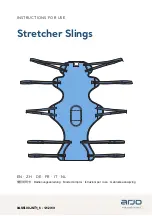
The Band Sling is designed to assist health care staff with
the support and positioning of limbs. Providing proper limb
support can assist staff with wound dressing, wound prepa-
ration, leg/venous wrapping, foot care, cleaning and a vari-
ety of other care related tasks.
It has been recommended, by the National Association of
Orthopaedic Nurses (NAON), that limb lifting be limited to a
maximum of 11.1 lbs. The average weight of a 200lb. Pa-
tient leg is approx. 35-37lbs.
It is important the sling be applied as to reduce the risk of
skin irritation, during the application process. Thus it is rec-
ommended that the sling be folded in 1/3 or ½, such that
the strap is folded under the sling. The sling should be in-
serted under the leg/limb in areas of limited leg-bed con-
tact, for example the back of the knee.
Once the sling is in place the folded portion of the leg strap
can be removed gently, avoiding skin contact.
In some cases, due to limb size or technique, it may be
advantageous to utilize two band slings. This may require
the band slings to be moved during the procedure, but
does provide maximal support.
The band sling can also be applied through the standard,
log roll application method.
“
Specialty Applications
”
Due to the limited amount of material utilized in the con-
struction of the band sling it may be an excellent choice
when turning patients, elevating particular areas of the
body for easier access.
•
Placing under the hips may allow a slight elevation of the
hips, into a slight pelvic bridge position.
•
The band sling, placed under the shoulder, may allow
elevation of the shoulder/torso for access to the head,
scalp, hair etc.
Revision Date: Feb. 10, 2010





